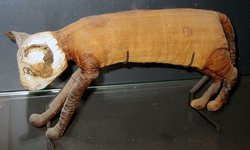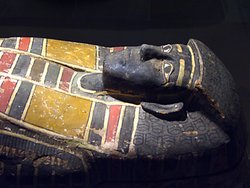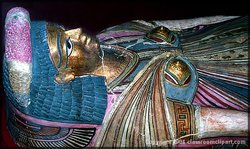Mummy
|
|
A mummy is a preserved corpse that, due to shielding from decomposition by either natural or artificial means, has retained its physical form. This can be achieved by exposing the body to extreme draught or cold, lack of oxygen, or use of chemicals.
The best-known mummies are those that have been embalmed with the specific purpose of preservation, particularly those in ancient Egypt. Egyptians believed the body was home to a person's Ka which was essential in one's afterlife.
In China, preserved corpses have been recovered from submerged cypress coffins packed with medicinal herbs.
Mummies formed as a result of naturally occurring environmental conditions, such as extreme cold (�tzi the Iceman), acid (Tollund Man) or desiccating dryness have been found all over the world. Some of the best-preserved mummies formed under natural conditions date from the Inca period in Peru.
| Contents |
Etymology
The English word mummy is derived from mediaeval Latin mumia, a borrowing of the Arabic word mūmiyyah (مومية), which means "bitumen". (Because of the blackened skin of unwrapped mummies, bitumen was once thought to be used extensively in ancient Egyptian embalming procedures. Asphalt and tar are forms of bitumen.) The Arabic word was itself borrowed from the Persian word mūmiya, meaning "bitumen"; this is related to another Persian word, mūm, which means "wax". (The ancient Greek historians record that the Persians sometimes mummified their kings and nobility in wax, though this practice has never been documented in Egypt.)
Mummies in Ancient Egypt
In Egypt, the dead were originally not mummified with the extensive process that happened during the first dynasty. The dead were originally buried in reed caskets in the sand. The searing hot sand caused the remains to dry quickly, preventing decomposition. After a while, though, they started constructing wooden tombs, and the extensive process of mummification was made so that the bodies would not decompose in the afterlife. The mummified individual was placed at his/her final resting place through a set of rituals and protocol.
The earliest known 'mummified' individual dates back to approximately 3300 BC, although it is not a 'true' mummy. The body is on display in the British Museum and has been given the nickname of 'Ginger' because he has red hair. Ginger was buried in the hot desert sand with maybe some stones piled on top to prevent the corpse being eaten by jackals. The hot, dry conditions desiccated the body, preventing the muscle and soft tissues from decaying. Ginger was buried with some pottery vessels, which would have held food and drink to sustain him on his long journey to the other world. There are no written records of the religion or gods from that time, and it is not known if it was the intention of the ancient Egyptians that the deceased were being preserved.
However, from the First dynasty onwards, the ancient Egyptians were trying preserve the bodies of the death, so their spirit had a body to guide them to the afterlife.
The Egyptians also expanded the practice of mummification to animals. Sacred animals central to cults, such as ibis, hawks, and cats, were mummified by the thousands.
Egyptian mummification process
Embalmers were given the task to preserve the deceased. Not only did their job require knowledge of human anatomy, they also had to perform rituals at several stages during the process.A typical mummification took 70 days in which craftsmen raced to finish the tomb.
The first step in a mummification was the removal of all internal organs which were prone to rapid decay. The brain was removed by breaking the bone at the end of the nose with a chisel and inserting a special hook up the nostrils and into the skull.
Embalmers also removed the stomach, liver, lungs and intestines through a small incision on the left side of the abdomen. Only the heart was left in place. The organs which were removed from the abdomen were stored in so called canopic jars, modelled after the four sons of Horus who would protect the organs, and placed in the tomb during the burial ritual. In later dynasties, these organs were treated and wrapped and returned to the body, but unused canopic jars continued to be placed into tombs. The incision was covered with a metal plate bearing the Eye of Horus (wedjat) which symbolically healed it.
Next, all moisture would be removed from the body, by covering it in natron, a type of salt found on the banks Lake Wadi Natrun. The result was a dried-out, but recognizable body.
Finally, the body was wrapped in large amounts of linen, some of which contained spells to help the deceased in their passage to the afterlife. After several stages of wrapping, the body would also be coated in warm resin, before wrapping was continued.
To further protect the deceased, magical amulets were placed on specific parts of the body between the layers of wrappings. These included:
Egyptian burial rituals
Finally, the mummy would be interred in varying ways that were dictated by the social status of the deceased. Relatively low-status individuals would simply be mummified and laid in a simple tomb or on a ledge in a larger tomb. Higher-status individuals would be interred in an elaborately decorated case, though perhaps not a stone sarcophagus. The highest-status individuals, such as pharoahs, would be interred in a set of nesting mummy cases and sarcophagi, which were often extremely elaborate.
Open problems
Why did the Egyptians mummify the deceased? When did the process of mummification originate? How was the "Myth of Osiris" tied to mummification ?
Mummies in other civilizations
A number of other civilizations are known to have practised the art of mummification.
- Aztecs
- Incas, a practice also adopted by peoples they conquered, e.g. Chachapoyas.
- Japan, see external link Buddhist mummies in Japan, PubMed (http://www.ncbi.nlm.nih.gov/entrez/query.fcgi?cmd=Retrieve&db=pubmed&dopt=Abstract&list_uids=8237299).
- Tibetans, who reserved this honor for people who reached a highest level of enlightenment.
Chinese mummy
Main article: Tarim mummies
Chinese mummies of an Indo-European type have been found in the Tarim Basin dating to as early as 1600 BC and suggesting very ancient contacts between East and West. It has been suggested that these mummified remains may have been the work of the ancestors of the Tocharians whose Indo-European language remained in use in the Tarim Basin (Modern day Xinjiang in China) until the 8th century CE (see Silk Road: Tocharians).
An ancient mummy dubbed the "handsome Yingpan man" was found in China's remote northwest province of Xinjiang. Archaeologists from the Xinjiang Archeological Institute found the mummified body when they opened a coffin in a graveyard dating back 1,900 years, according to Xinhua news agency. The mummy had thick brown hair, a shrunken face and body, and gray and brown skin. Its beard, eyebrows and eyelashes were clearly discernible and its clothes were intact and retained their bright color.
The mummified man, believed to have lived during the Eastern Han Dynasty (25-220 AD), was 1.8 meters (nearly six feet) tall and might have died at about 25 years of age. His coffin which had colorful paintings on the outside was discovered together with over 150 ancient tombs dating back to the Eastern Han Dynasty at Yingpan near Lop Nur in the Xinjiang Uighur Autonomous Region. This coffin along with five others had been shipped to Urumqi, the regional capital, and were kept in the institute, unopened, for three years. The mummy is believed to be significant for the study of economic and cultural exchanges between China and Western countries in ancient times.
The "handsome Yingpan man" is thought to be comparable to the "beautiful Loulan woman," a 3,800-year-old female mummy discovered in 1980 at the Tiebanhe Delta, about 200 kilometers east of Yingpan, said the report. Loulan was an ancient kingdom along China's Silk Road in Xinjiang, about 200 kilometers east of Yingpan.
Natural mummies
Natural mummification is fairly rare, due to the requirement for certain specific conditions, but it has produced some of the oldest known mummies. The most famous ancient mummy is �tzi the Iceman, frozen in a glacier in the �tztaler Alps around 3300 BC and found 1991. An even older but less well preserved mummy was found in Spirit Cave, Nevada in 1940 and carbon-dated to around 7400 BC.
England, Ireland, Germany, the Netherlands and Denmark have all produced a number of bog bodies, mummies of people deposited in sphagnum bogs apparently as a result of murder or ritual sacrifices. In such cases, the acidity of the water, the cold temperature and the lack of oxygen combine to tan the body's skin and preserve the skeleton. Such mummies are remarkably well preserved, with skin and internal organs surviving as well as skeletons; it is even possible to determine what their last meal was by examining their stomach contents.
In 1972, eight remarkably preserved mummies were discovered at an abandoned Inuit settlement called Qilakitsoq, in Greenland. The "Greenland Mummies" consisted of a six-month old baby, a four year old boy, and six women of various ages, who died around 500 years ago. Their bodies were naturally mummified by the sub-zero temperatures and dry winds in the cave in which they were found.
Some of the best-preserved mummies date from the Inca period in Peru some 500 years ago, where children were ritually sacrificed and placed on the summits of mountains in the Andes. The cold, dry climate had the effect of dessicating the corpses and preserving them virtually intact for centuries.
Mummies in recent times
Mummies have been an object of intense interest in the West since archaeologists began finding them in large numbers. 19th-century aristocrats would often entertain themselves by buying mummies, having them unwrapped, and holding observation sessions. These sessions destroyed several mummies, because the exposure to the air caused them to disintegrate.
In the 1830s Jeremy Bentham, the founder of utilitarianism, left instructions to be followed upon his death which led to the creation of a sort of modern-day mummy. He asked that his body be displayed to illustrate how the "horror at dissection originates in ignorance"; once so displayed and lectured about, he asked that his body parts be preserved, including his skeleton (minus his skull, for which he had other plans), which was to be dressed in the clothes he usually wore and "seated in a Chair usually occupied by me when living in the attitude in which I am sitting when engaged in thought." His body, outfitted with a wax head created because of problems preparing his head as Bentham requested, is on display in the University College London.
Egyptian mummies were much sought-after by museums worldwide in the 19th and early 20th centuries and many exhibit mummies today. Notably fine examples are exhibited at the Egyptian Museum in Cairo, at the �gyptisches Museum in Berlin, and at the British Museum in London. The Egyptian city of Luxor is also home to a specialised Mummification Museum. The mummified remains of what turned out to be Ramesses I ended up in a "Daredevil Museum" near Niagara Falls on the United States–Canada border; records indicate that it had been sold to a Canadian in 1860 and exhibited alongside displays such as a two-headed calf for nearly 140 years, until a museum in Atlanta, Georgia, which had acquired the mummy along with other artifacts, determined it to be royal and returned it to Egypt's Supreme Council of Antiquities. It is currently on display in the Luxor Museum.
Mummies were also believed to have medicinal properties, and were sold as pharmaceuticals in powdered form. However, they were not used as fuel for steam locomotives, and the idea that they were came from a joke by Mark Twain. However, during the First World War, mummy wrapping linens were manufactured into paper.
During the 20th century, horror films and other mass media popularized the notion of a curse associated with mummies. Films representing such a belief include the 1932 film The Mummy starring Boris Karloff, as well as two remakes, one released in 1959 and another in 1999. The belief in cursed mummies probably stems in part from the supposed curse on the tomb of Tutankhamun.
Science has also taken notice of mummies. Dr. Bob Brier, an Egyptologist, has been the first modern scientist to successfully recreate a mummy using the Egyptian method. Mummies have been used in medicine, to calibrate CAT scan machines at levels of radiation that would be too dangerous for use on living people. In fact, mummies can be studied without unwrapping them using CAT scan and X-ray machines to form a picture of what's inside.
They have been very useful to biologists and anthropologists, as they have provided a wealth of information about the health and life expectancy of ancient peoples. In particular, mummies have demonstrated that even 5,000 years ago, humans were anatomically indistinguishable from their present-day counterparts. This has had important repercussions for the study of human evolution.
Scientists interested in cloning DNA of mummies have recently reported findings of clonable DNA in an Egyptian mummy (http://www.ncbi.nlm.nih.gov/entrez/query.fcgi?cmd=Retrieve&db=pubmed&dopt=Abstract&list_uids=3990798&itool=iconabstr) dating to circa 400 BC. Although analyzing the hair of Ancient Egyptian mummies from the Late Middle Kingdom has revealed evidence of a stable diet [1] (http://www.ncbi.nlm.nih.gov/entrez/query.fcgi?cmd=Retrieve&db=pubmed&dopt=Abstract&list_uids=10091248&itool=iconabstr), Ancient Egyptian mummies from circa 3200 BC show signs of severe anemia and hemolitic disorders [2] (http://www.ncbi.nlm.nih.gov/entrez/query.fcgi?cmd=Retrieve&db=pubmed&dopt=Abstract&list_uids=11148985&itool=iconabstr). Traces of cocaine, hashish and nicotine have also been found in the skin and hair of Egyptian mummies [3] (http://www.ncbi.nlm.nih.gov/entrez/query.fcgi?cmd=Retrieve&db=pubmed&dopt=Abstract&list_uids=7702279&itool=iconabstr).




